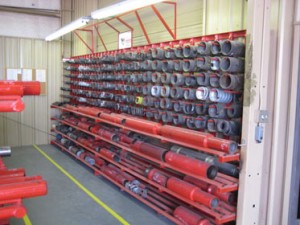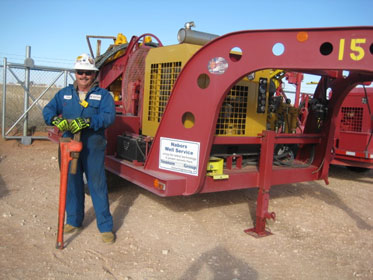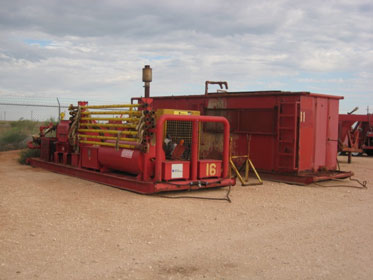The business of “fishing” a well bore requires skill, technology—both new and tried-and-true—and a mechanical aptitude as well. Like everything else, this trade keeps changing, too.
Fish: Anything left in a wellbore.
Fishing: To attempt to retrieve a fish from a wellbore.
The Oilfield Glossary compiled by Schlumberger explains a complicated industry process in a few simple words. Those words don’t explain how difficult the procedure can be or that it can involve several days of work. In these times when more wells are being drilled vertically and horizontally and into more plays and with older wells being re-opened, fishing companies are fielding more calls for a crew and equipment to retrieve a lost object in a hole.
Workers new to the industry often are confused when they hear someone talking about “fishing” and “fishermen.” Looking around the parched land that comprises the Permian Basin, they wonder where the best fishing hole is located.
The answer is: Everywhere.
Historically, fishing has played an important role in the drilling industry. Schlumberger’s glossary noted that “It does not matter whether the fish consists of junk metal, a hand tool, a length of drillpipe or drill collars, or an expensive MWD and directional drilling package. Typically, anything put into the hole is accurately measured and sketched, so that appropriate fishing tools can be selected if the item must be fished out of the hole.”
And almost all the items must be fished out of the hole.
Enos Johnson has done a lot of fishing in his 38 years in the business. He works as district manager of the Hobbs, N.M., office of SERVCO, which is the fishing division of Schlumberger.
“In the drilling process, a well bore can heave in on them, or a boulder can fall in the bore. The pipe gets stuck and the crew can’t get the pipe out,” he said. Sometimes the fishermen, as the specialists are called, encounter hydrostatic stick. Fluid goes into the zone and pulls the item to the wall of the well bore, like paper being stuck to the wall.
Another situation is called “key seated,” said Johnson. “It’s like a keyhole in a doorknob. The drilling process hits a soft spot and the drill bit “walks off” and must be straightened back.
In some cases, a wireline truck is used to find out where the pipe is in the hole. “We go in with an overshot or use hydraulic jars to try to jar the pipe loose. We can go in with a wash pipe and wash over the string and pull it out of the hole.
“Sometimes there is pipe fatigue and the pipe will break off. We have to go in and retrieve it. Iron is iron and it’s going to break.” Another problem occurs when the earth’s magnetic field produces electrolysis and the pipes become stuck.
The Schlumberger Oilfield Glossary explains that special mechanical devices are used to help “fish” the equipment lost downhole. This equipment falls into four classes: diagnostic, inside grappling, outside grappling, and force intensifiers or jars.
The glossary explains that diagnostic tools can include a simple impression block to help the fisherman custom design a tool that can attach to the fish and remove it. Other diagnostic tools include electronic instruments and downhole sonic or visual-bandwidth cameras.
Inside grappling devices, called spears, usually have a tapered and threaded profile which enables a fisherman to guide the tool into the top of the fish and thread it into that top so the tool can be retrieved. Outside grappling devices, called overshots, are fitted with threads that “swallow” the fish and pull it out of the hole. Jars are mechanical downhole hammers that deliver high impact loads to the fish.
Problems also can occur once production is going. Johnson said a company will notice production is going down on a certain pumping unit and call in a fishing unit. “The pipe could be stuck, the hole might have collapsed, or there wasn’t a good cement job in the pressure zone,” he explained.
Nabors Well Services, Ltd., is among the biggest of the Permian Basin’s well servicing companies and responds to a steady stream of requests for fishing operations. Craig Fletcher, operations superintendent for Nabors’ yard in Denver City, said the company is very busy right now.
“There are many different scenarios and a variety of services associated with what we do,” Fletcher said. “The best way to describe it might be to say that we provide remedial repair and fishing services and can deepen wells with our equipment.” Their customers include Hess, Oxy, Sandridge, Devon, XTO, and Apache, and calls take their crews up to northern and western New Mexico, South Texas, and the Eagle Ford play near San Antonio.
While part of Nabors’ business can be attributed to the current boom in drilling, Fletcher also pointed out that many of the wells in this area of West Texas were drilled from the 1930s to the 1970s.
“For one reason or another, the casing and the tubing can get in bad shape and that is where we come in,” Fletcher said. “We encounter a lot of bad casing and we stay busy repairing it.”
The Permian Basin has its own unique challenges in terms of fishing services, and part of it is attributed to the success this region has known. The age of those wells and the drilling practices at that time can contribute to problems today. “The Permian wells have lasted so long and have been so prolific, that some of these wells have been producing over 60 years,” he said. “When these wells were drilled, it was never anticipated they would last this long. If the drillers had anticipated it, they would have run things differently, and made them even more durable than they did. They could have used thicker pipe, done better cement jobs.”
Clyde Hinton, who started Hinton Enterprises in Odessa in 1994, agrees that much of their work is done on older wells. “The older wells are a majority of our business,” he said. “We try to keep them producing.”
Fishing tools haven’t changed much over the decades, according to Hinton, who ventured in 1968 into the oil patch to first, plug wells, and then to service them before trying his hand at fishing.
“The changes have been very few,” he said. “Most of the tools are common: things like a grapple and a spear. We use a lot of mills that smooth the surface of the fish so we can get a better hold on it. Various sizes of tools are needed and we have to build up a good inventory.” In addition to sending crews out to the field, Hinton Enterprises offers equipment for rent. People who are experienced in oilfield work are the ones who will rent equipment and not hire a fishing crew with it.
Johnson with SERVCO added, “A lot of tools haven’t changed in years. You have a tool that works and nobody has come up with anything that works better.”
Changes in the fishing business have come in the types of wells where the tools are needed and technology used in the wells.
Weatherford International, a major player in the well servicing industry, also does a lot of fishing. Bobby Duncan, area manager for Weatherford’s Midland yard, said one of the biggest changes affecting the fishing trade is the trend toward more production work and away from as much “open hole” fishing.
Even as recently as five years ago, open hole work was more prevalent, he said. But the majority of new wells today are oil wells, and technological advances on those wells mean fewer reasons to fish.
Technology has changed some aspects of the business, though. Fletcher with Nabors noted that back when the wells were drilled in the 1940s and 1950s, “everything was rotary rigs. Now they have top-drive rigs and they can measure and log while they are drilling. They can steer the bit wherever they want.”
However, that can make the fishing more difficult, he noted. “If you drill a mile down and then a mile horizontal, you’ve got more frictions because the pipe is turned.”
Duncan, at Weatherford International, observed that newer technology has meant that fishing can be avoided entirely, in some instances. With steerable bits, drillers can turn the bit and can bypass the fishing chore. “They can simply back up the drill and take a different direction, bypassing the object that was lodged in the well bore.”
Another consideration that Duncan pointed out about horizontal wells is that the vertical portion, which is often shallower than vertical segments on the older wells, is easier to fish because the job “doesn’t take as long to make a trip.” Conversely, “with a 15,000-foot gas well, it takes a lot longer to go [to the bottom].” He sees more fishing activity concentrated on the production end as contrasted with the exploration side.
Johnson has encountered more difficulty when fishing on some horizontal wells. “Some stuck pipes on a horizontal wells can be cased and some are open. There are different situations when you have to clean up something: how steep of an angle you need to go and how far out it goes,” he said.
In August, Hinton’s company was fishing at a horizontal well and encountering some problems. “It’s more difficult. You need specialty tools to go in the hole at a certain direction,” he said.
During past decades when wells were shallower, fishing posed a relatively economical option. “It was more cost effective to fish the gas wells then,” said Weatherford’s area manager. “Today, instead of spending money in fishing, it is easier and more economical to drill around it.”
In some difficult cases, the owner needs to decide whether to proceed on the fishing or to plug the well. “The rig is down while undergoing the fishing procedure. They could lose the well, even at 6,000 feet,” Johnson said.
A video produced by Key Energy explains an equation that can be used to figure the cost effectiveness of a fishing job.
D=(V+Cs)÷(Fd+Rd)
D = maximum days to fish
V = value of fish
Cs = cost of sidetrack
Fd = fishing daily cost
Rd = rig daily cost
The petroleum engineering student intern featured in the video concludes: “When you complete this equation, you will end up with a value that represents the number of days allotted for a cost efficient fishing job.”
Johnson noted that the New Mexico Oil Commission could become involved if the fish can’t be pulled out and the well needs to be plugged. The commission wants to know “where the well is, what damage it might do in the future and if any chemicals could get into the freshwater zone. They might require the well bore to be cased and plugged properly.”
The “fish” can be anything and everything, which accounts for the variety of tools and procedures.
In his 38 years in the fishing industry Johnson has seen a variety of unusual items pulled out of the ground. Employees at SERVCO used to mount the more unusual ones for visitors to see.
“I’ve had some old tools from the late 1940s and early 1950s fished out. Some were homemade tools. Nothing was built to specs. We had to go to some oldtimers to see what they were,” Johnson said. Other items include submersible pumps, sucker rods, electric cables, and even the fishing tools. “We’re on a job now where we’re fishing out a submersible pump. Those pumps can be expensive. We’ve been on the job a week now. It’s not an easy job.”
Hinton, too, has seen a variety of articles pulled out of the holes, including trees that were used to plug a hole. These were found when a company tried to go back into the hole. “Sometimes a crew gets mad and quits and they throw all their tools into the well,” he added.
The hardest thing to fish out of a well bore, according to Nabors’ Fletcher, “are the fishing tools themselves. Yes, it does happen. We take precautions: we inspect them and replace them if there is any doubt about the strength or integrity of the tool. We might do a magnaflux inspection, check the wall thickness. You do everything you can to see that losing a tool won’t happen, but sometimes it does.”
Finding employees who can learn the specialized field of “fishing” can pose  another problem to the companies. Hinton worked several years learning how to fish before opening his business. “You have to have a lot of knowledge to fish wells. Not just everybody can do it.”
another problem to the companies. Hinton worked several years learning how to fish before opening his business. “You have to have a lot of knowledge to fish wells. Not just everybody can do it.”
“You can teach someone the fundamentals of the tools and how to use them,” Johnson said. “But it takes time and experience for them to learn it. You can’t just take someone off the street to be a fisherman. Even someone who works on a well can’t jump into this overnight. Someone who is mechanically inclined might catch on faster. This is a skilled profession. I have several good hands and all of them work production and open hole fishing. My hands are pretty steady; some have been here 10 to 12 years.”
A column written by Armando Arenivas for the Midland Reporter-Telegram’s August 12, 2012, edition humorously explains the business:
“While they were eating, the kid asked the other hands what happened. Pointing at the reserve pit, he said he thought they were going to be fishing. The hands laughed and told the kid there were no fish in that lake (the reserve pit). The hands explained they had lost some drill collars in the hole and the fishing part was trying to retrieve them.”











